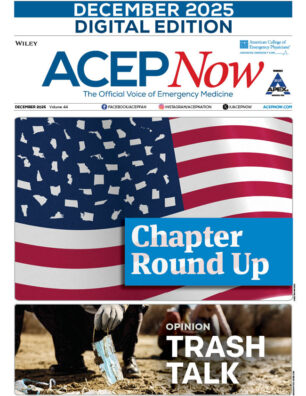
When we encounter overt racism and other forms of discrimination in the workplace, we expect our colleagues of all backgrounds to stand strongly against it. After all, this is the 21st century.
Explore This Issue
ACEP Now: Vol 39 – No 01 – January 2020But there is a perception, even among many of our allies, that a relative paucity of open, unconcealed, and uncensored intolerance or prejudice in the workplace means that the effects of these entities are somehow absent. We know that is not the case.
And while people basically know what to do (and what is expected of them) in the face of pure unadulterated bigotry in the workplace, the same can’t be said of more subtle digs and jabs, whether intentional or not. These remarks or attacks have a name: microaggressions.
What Is a Microaggression Anyway?
Microaggressions are “brief and commonplace daily verbal, behavioral, and environmental indignities, whether intentional or unintentional, that communicate hostile, derogatory, or negative…slights and insults.”1 The “micro” portion of the expression refers to the perception by the aggressor, not in the hurtful impact this form of aggression can have.
Being on the receiving end of microaggressions in the health care workplace can result in provider burnout and attrition. Often, microaggressions go unrecognized by bystanders because bystanders may not realize something offensive was said, or they just don’t know how to respond.
Before delving into what allies can do to help combat microaggressions, it’s important to have a more comprehensive understanding of them. There are several subcategories of microaggressions, including microinsults, microinvalidations, and microassaults.2
- Microinsults, often unconscious, are characterized by behavioral/verbal remarks or comments that convey rudeness and insensitivity and demean a person’s heritage or identity.
- Microinvalidations, also often unconscious, are verbal comments or behavior that exclude, negate, or nullify the psychological thoughts, feelings, or experiential reality of the targeted person.
- Microassaults, more often conscious, are explicit derogations characterized primarily by a violent verbal or nonverbal attack meant to hurt the intended victim through name-calling, avoidant behavior, or purposeful discriminatory actions.
Often when someone hears or experiences a microaggression, they experience an internal dilemma: “Did I interpret that correctly?” or “Did she say what I think she said?” or “Should I say something?” For their part, sometimes well-meaning bystanders who have noticed it are concerned that saying something might only make it worse or that speaking up would add more hurt than it might help.
However, the person directly on the receiving end is likely experiencing a wave of emotions, including humiliation and helplessness. Down the road, these feelings can result in anxiety, depression, sleep difficulties, and diminished confidence. Additionally, racial and gender microaggressions can and do compound, ultimately creating an inhospitable workplace environment that too often leads to attrition.
The power dynamics of the relationships of the players involved also influence how the recipient may feel about responding to the microaggression, both in real time and later. Relationship dynamics can range from colleague-colleague and clinician-patient to supervisor-supervisee. Each situation is unique, with complexities that are difficult to fully understand, thus making their downstream effects more difficult to mitigate.
This is why we need to band together to respond to microaggressions when they happen.
What We Can Do
There are many good reasons to confront a microaggression, both for the offender and the offended. These include helping the offender (who often did not mean to cause harm) realize their bias, changing behavior, and setting a norm that the behavior is neither tolerable nor acceptable.
People tend to judge themselves by their intentions. If they consider themselves to be thoughtful and kind, then the intent of their comment may conflict with its impact and its unintended consequences. When speaking out against a microaggression, we have to be aware that the person being called out can be expected to react in a range of ways, from anger, denial, and minimization to guilty or apology. These are all natural reactions.
That is why one of the bystander strategies for combatting microaggressions is to take action as they occur. Here are some strategies for interrupting and intercepting microaggressions.3
- Ask a clarifying question.
- Come from a place of curiosity, then listen actively and openly.
- Tell others about your experience: “I noticed that…”
- Encourage others to consider the impact of their words or actions: “How do you think people feel when..?”
- Own your response. “When I hear your comment, I think/feel…”
- Identify next steps and request appropriate action. “I’d appreciate if you would not…”
For those in supervisory positions, several actions can be taken to help create a workplace environment that minimizes microaggressions. First, set expectations for a safe learning or workplace environment. Second, encourage staff and trainees to speak up when they feel uncomfortable about a situation. Third, if you experience a microaggression, share your story so that others may feel more comfortable sharing their stories. Finally, use of “interrupting microaggression” strategies should be consistently encouraged and modeled to set an example for others in the workplace.
While microaggressions may seem small, they are not. Fortunately, it does not take heroic efforts to stop them from causing immediate and downstream hurt and diminishing the quality of our workplace. However, it takes awareness and willingness to act. Working together, we can prevent the macro effects of microaggressions and decrease their prevalence in the process.
“The Equity Equation” is curated by Dara Kass, MD, and Uché Blackstock, MD.
 Dr. Blackstock is CEO and founder of Advancing Health Equity.
Dr. Blackstock is CEO and founder of Advancing Health Equity.
References
- Sue DW, Capodilupo CM, Torino GC, et al. Racial microaggressions in everyday life: implications for clinical practice. Am Psychol. 2007;62(4):271-286.
- Hopper E. What is a microaggression? Everyday insults with harmful effects. ThoughtCo. website. July 3, 2019. Accessed Dec. 19, 2019.
- Souza T. Responding to microaggressions in the classroom: taking ACTION. Faculty Focus website. April 30, 2018. Accessed Dec. 19, 2019.
Pages: 1 2 3 | Multi-Page



One Response to “Simple Strategies for Combating Microaggressions in the Workplace”
March 5, 2021
julie.korenberg@hsc.utah.eduThis was well written. JRK